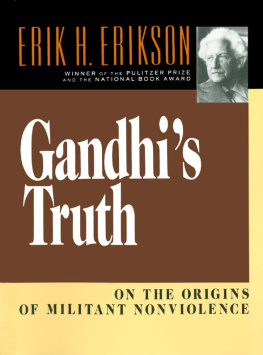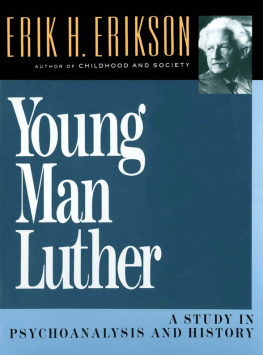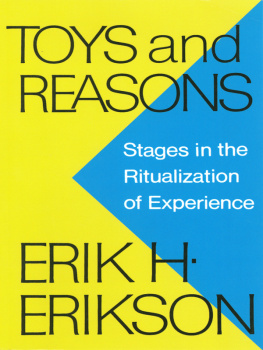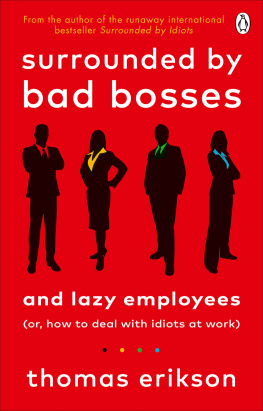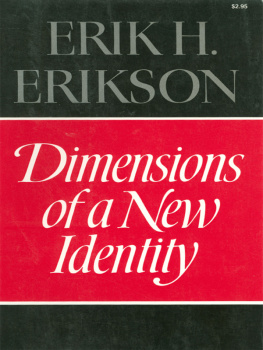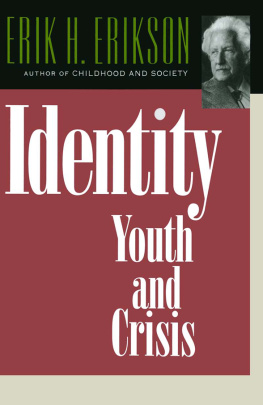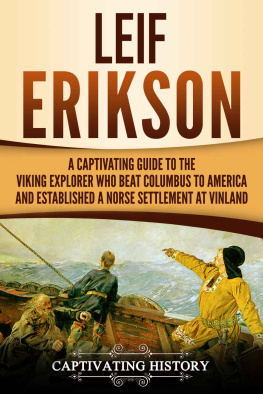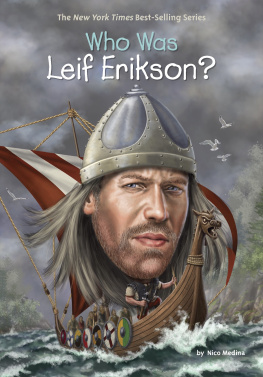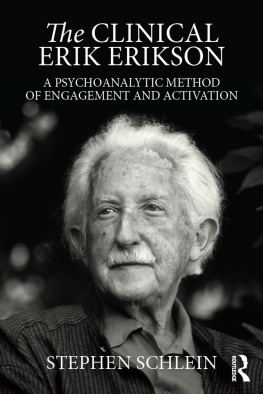
THE
Life Cycle
Completed
EXTENDED VERSION
BY ERIK H. ERIKSON
Childhood and Society (1950, 1963)
Young Man Luther (1958)
Insight and Responsibility (1964)
Identity: Youth and Crisis (1968)
Gandhis Truth (1969)
Dimensions of a New Identity (1974)
Life History and the Historical Moment (1975)
Toys and Reasons (1977)
Identity and the Life Cycle (1959, 1980)
The Life Cycle Completed (1982)
Vital Involvement in Old Age (with Joan M. Erikson and
Helen Q. Kivnick) (1986)
A Way of Looking at Things: Selected Papers
from 1930 to 1980 (edited by Stephen Schlein, Ph.D.) (1987)
EDITED BY ERIK H. ERIKSON
Adulthood (1978)
BY JOAN M. ERIKSON
Legacies: Prometheus-Orpheus-Socrates
The Universal Bead
St. Francis and His Four Ladies
Activity, Recovery, Growth
Wisdom and the Senses
Copyright 1997 by Joan M. Erikson. Copyright 1982 by Rikan Enterprises Ltd.
First published as a Norton paperback 1998
All rights reserved
Printed in the United States of America
For information about permission to reproduce selections from this book,
write to Permissions,
W. W. Norton & Company, Inc., 500 Fifth Avenue, New York, NY 10110.
The text of this book is composed in 11/13 Janson
with the display set in Deepdene
Manufacturing by the Haddon Craftsmen, Inc.
Library of Congress Cataloging-in-Publication Data
Erikson, Erik H. (Erik Homburger), 19021994
The life cycle completed : a review / Erik H. Erikson. Extended
version / with new chapters by Joan M. Erikson.
p. cm.
Includes bibliographical references.
ISBN 0-393-03934-X
ISBN 978-0-393-34743-2 (e-book)
1. Developmental psychology. 2. Psychoanalysis. 3. Personality.
I. Erikson, Joan M. (Joan Mowat) II. Title.
BF713.E73 1997
155dc20
96-34622
CIP
W. W. Norton & Company, Inc.
500 Fifth Avenue, New York, N.Y. 10110
www.wwnorton.com
W. W. Norton & Company Ltd.
Castle House, 75/76 Wells Street, London WIT 3QT
THE TERM AND CONCEPT, psychosocial, in a psychoanalytic context, is obviously meant to complement the dominant theory of psychosexuality. To chart the beginnings of such an effort I must go back to the time of my training in Viennathe period of ascendance of ego psychologyand briefly trace some changing conceptualizations of the egos relation to the social environment. True, the two basic works on the ego,Anna Freuds The Ego and the Mechanisms of Defence and H. Hartmanns Ego Psychology and the Problem of Adaptationappeared only in 1936 and in 1939, respectively. But the observations and conclusions on which these two works were based dominated much of the discussion in the years before the completion of my training and my migration to the United States in 1933. The defensive and the adaptive functions of the ego have, in the meantime, become firm facets of psychoanalytic theory. My purpose in referring back to their origins is to indicate in what way, to a young worker, the overall theory seemed to be working toward and yet stopping short of a systematic attention to the egos role in the relationship of individuality and communality.
Most interesting in retrospect and most indicative of the hidden ideological controversies that mark the advancement of a field was the original discord between A. Freuds and Hartmanns emerging ideas. Anna Freud herself, in her straightforward way, reports that when she first formally submitted her conclusions regarding the defensive functions of the ego to the Vienna Society in 1936, Hartmann showed himself appreciative on the whole, but he emphasized the point that to show the ego at war with the id was not the whole story, that there were many additional problems of ego growth and ego functioning which needed consideration. My views were more restricted at the time, and this was news to me which I was not yet ready to assimilate. For, she continues, her contribution came from the side of the egos defensive activity against the drives; Hartmanns, in a more revolutionary manner, from the new angle of ego autonomy which until then had lain outside analytic study (Loewenstein et al. 1966).
The last three words, as well as the designation revolutionary, point to the question of self-chosen boundaries drawn at various times in the development of psychoanalytic theory. To appreciate these, we would need to consider the ideological as well as the scientific implications of every advance and of every corresponding term in psychoanalytic theory, and, indeed, in all applications of theories of natural science to man. Freuds original position, of course, was drive oriented, and my generation of men and women trained in Middle Europe will remember that this most fundamental of all terms, Trieb, in its German usage had a number of nature-philosophical connotations as an ennobling as well as an upsetting force: this (for better or for worse) was lost in its translation into either instinct or drive. Die suessen Triebethe sweet drives,the German poet could say: while stern physiologists could speak of the obligation in all work worthy of the name of science to find forces of equal dignity(Jones 1953)equal to those already isolated and quantified in the natural sciences. But if Freud insisted that all our provisional ideas in psychology will presumably some day be based on an organic substructure (1914), he also made it clear that he was willing to wait for a truly reliable experimental substantiation of an all-inclusive and then still admittedly mythical instinctual energy. Thus we learned that he was opposed to Reichs materialistic attempts to find measurable traces of libido in the tonus of some body surfaces.
Freuds work had begun in the century of Darwins search for the evolutionary origin of the species; and the new humanist ethos demanded that mankind, once so proud of the consciousness and the moral stature of its assumed civilized maturity, would have to accept the discovery of its primary roots in its animal ancestry, in its own primeval prehistory, and in the infantile stages of ontogeny. All this, at any rate, was once implied in that terminology of instinctual energy that over the years has come to convey a certain ritualistic conviction rather than the persistent hope of strict scientific substantiation. In its time, however, that energetic form of thought opened up undreamt-ofor was it dreamt-ofinsights. The purpose of drawing his line there, however, was (as the recently published correspondence between Freud and Jung has again so dramatically illustrated) Freuds conviction of the prime necessity to study vigilantly that unconscious and instinctual core of man which he called the id (and thus something akin to an inner outerworld) and to take no chances with mankinds tenacious resistance to insights into its lower nature, and its tendency to devitalize such insights by remythologizing them as higher. No wonder, then, that social reality, in relation to the inner cauldron to be explored, at first occupied something of an extraterritorial position and, more often than not, was referred to as the outer-world or external reality. Thus, our proud ego, which Freud called a frontier creature, owes service to three masters and is consequently menaced by three dangers: from the external world, from the libido of the id, and from the severity of the super-ego (S. Freud 1923).
Next page

